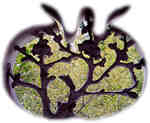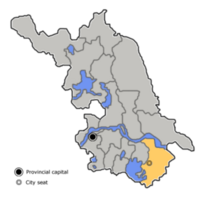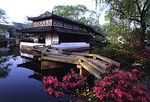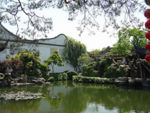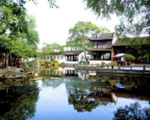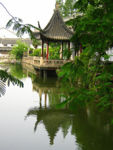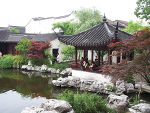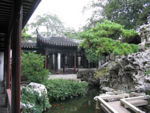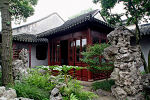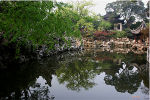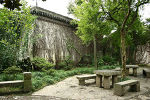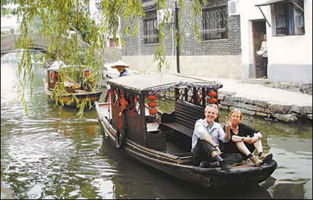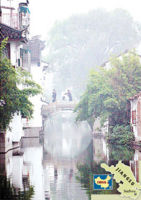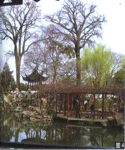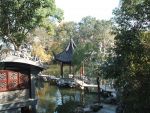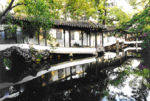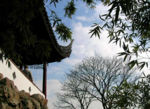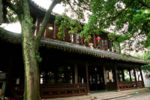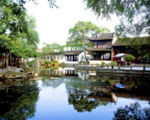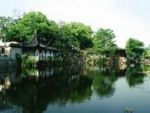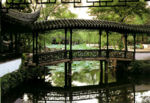Suzhou: Difference between revisions
No edit summary |
|||
| (319 intermediate revisions by 5 users not shown) | |||
| Line 8: | Line 8: | ||
| '''Country''' || style="background:Lavender"|''China'' | | '''Country''' || style="background:Lavender"|''China'' | ||
|- | |- | ||
| '''Topic''' || style="background:Lavender"|'' | | '''Topic''' || style="background:Lavender"|''Classical gardens of Suzhou'' | ||
|- | |- | ||
| '''Author(s)''' || style="background:Lavender"|''Zhang Yujun'' | | '''Author(s)''' || style="background:Lavender"|''Zhang Yujun'' | ||
| Line 14: | Line 14: | ||
| '''Completion''' || style="background:Lavender"|''Please enter the date of completion'' | | '''Completion''' || style="background:Lavender"|''Please enter the date of completion'' | ||
|- | |- | ||
| '''Client''' || style="background:Lavender"|'' | | '''Client''' || style="background:Lavender"|''Gardens Bureau of Suzhou'' | ||
|- | |- | ||
| '''Project costs''' || style="background:Lavender"|''Please enter the costs (if known)'' | | '''Project costs''' || style="background:Lavender"|''Please enter the costs (if known)'' | ||
|- | |- | ||
| colspan="3" align="center" style="background:silver"| [[Image: | | colspan="3" align="center" style="background:silver"| [[Image:The_canglang_pavilion.jpg|300px]] | ||
|- | |- | ||
| ||style="background:Lavender"| | | ||style="background:Lavender"| | ||
|- | |- | ||
| colspan="3" align="center" style="background:silver"| <googlemap version="0.9" lat="31. | | colspan="3" align="center" style="background:silver"| <googlemap version="0.9" lat="31.325193" lon="120.624948" type="satellite" zoom="15" width="300" height="300"> | ||
</googlemap> | </googlemap> | ||
|} | |} | ||
=== Rationale: Why is this case study interesting? === | === Rationale: Why is this case study interesting? === | ||
The case is a investigation of the garden status of Suzhou in China. It's also the project in our workshop. The gardens are a brilliant part of Chinese cultural heritage. I'd like to let more and more people know the gardens of Suzhou in China. The gardens characteristics are as follows: | |||
in | <gallery caption=" " widths="150px" heights="150px" perrow="5"> | ||
Image:1shi.jpg|''Rockery in garden'' | |||
Image:2chuang.jpg|''Flower windows in garden'' | |||
</gallery> | |||
#they set fine examples of how garden spaces are ingeniously handled. | |||
#they are the re-creation of the splendors of natural scenery through the processes of the decoration of land by planting trees, shrubs and flowers, and designing and materializing mountains and watercourses. | |||
#they are an epitome of exquisite and multifarious buildings of old times in the south of the Lower Yangtze. | |||
#they are rich in literary connotations ,carrying a tremendous amount of information about Chinese culture. | |||
To sum up, the classical gardens of Suzhou in the course of over two millennium have experienced many ups and downs, and gradually reached a state of artistic perfection. | |||
=== Author's perspective === | |||
The classical gardens as the heritage sites exist today is a very difficult thing. The gardens shows us not only the beautiful scenery, but also shows us the lofty technical of making the gardens and the upstairs develop of the social civilization at that time.Because the people are not only pay attention to the physical life, but also the psychis enjoy.And the physical life is the basic of the psychis enjoy, only the steady and peaceful society could offer this. | |||
The most important thing: we must put the protection of the world heritage in first place in order to search for the balance of protection and development and to make a better use of the garden resources. We should follow several requirements: | |||
#the restorative protection of the classical gardens. | |||
#the excavate protection of the classical gardens. | |||
#the constructive protection of the classical gardens. Because the gardens could witnessed the history and culture and provide us the beautiful enjoy. Because the gardens belongs not only to us, but also belongs to the world. | |||
=== Landscape and/or urban context=== | |||
<gallery caption=" " widths="300px" heights="200px" perrow="4"> | |||
Image:location.jpg|''Location in China'' | |||
Image:location in jiangsu.png|''Location in Jiangsu'' | |||
</gallery> | |||
*'''Urban context''' | |||
The beautifully landscaped city of Suzhou is located in the south-east of Jiangsu Province. The Grand Canal (Sui Dynasty 581-618), which flows from Beijing to Hangzhou (the capital of Zhejiang Province) has irrigated Suzhou aiding its illustrious culture and turning it into prosperous land. It is of little surprise that Suzhou is called ''Heaven on Earth''. | |||
Built in 541BC by He Lv, the King of Wu, 2500 year old, Suzhou is the birthplace of Wu culture. The 8,483km2 city is bustling with historical remnants and culture, thus placing Suzhou third behind Beijing and Xi'an for its historical and cultural significance. It has been named as one of China's top 24 historical and cultural cities and is only one of the four tourist cities with environmental protection (the other three being Beijing, Hangzhou and Guilin). In 1997, Suzhou caught the world's attention by having its classic gardens placed on the UNESCO list as a World Cultural Heritage site. | |||
Suzhou is a key silk production center in China and the embroidery school here is ranked in the "top 4" for the whole of China. The attractiveness of Suzhou is also evident in its performing arts (folk songs of Wu), Kunqu Opera and storytelling, as well as stale carving, calligraphy and painting. Dating back to more than 2,500 years, Suzhou is one of China's oldest cities. After the completion of the Beijing-Hangzhou Grand Canal the city began to thrive during the Sui Dynasty. | |||
*'''Climate''' | |||
Suzhou is located in the lower reach of the Yangtze River, belonging to the monsoon ocean climate zone, with slightly cold winter and humid summer. | |||
The best time to travel is during the spring and autumn seasons. | |||
[[Image:qihou.jpg]] | |||
=== Cultural/social/political context=== | |||
*'''Cuisine''' | |||
Yangcheng Lake huge crab | |||
[[Image:yangchenghu.jpg]] | |||
''Yangcheng lake'' | |||
* | *'''Chinese opera''' | ||
Kunqu originates in the Suzhou region, as does the much later Suzhou Opera. Ballad-singing, or Suzhou pingtan, is a local form of storytelling that mixes singing (accompanied on the pipa) with portions in spoken dialect. | |||
[[Image:qunqu000.jpg]] | |||
''Regional opera (Qunqu)'' | |||
* | *'''Traditional music''' | ||
Suzhou is the original place of "Jasmine", a song sung by Chinese singers or actresses thousands of times on the occasions of almost every important meetings or celebrations. Jasmine is also the symbol of Suzhou as well as Tai Hu Lake. | |||
*'''The Suzhou Museum''' | |||
It has a rich collection of relics from many eras. The collection includes revolutionary records, stale carving, folk customs, drama and verse, Suzhou embroidery, silk cloth, gardens, coins and Buddhist artifacts. | |||
[[Image:bowuguan.jpg]] | |||
''Suzhou museum'' | |||
*'''Handicrafts''' | |||
Suzhou embroidery, fans, national musical instruments, scroll mounting, lanterns, mahogany furniture, jade carving, silk tapestry, traditional painting pigments of Jiangenxutang Studio, the New Year's wood-block prints of Taohuawu Studio. | |||
[[Image:handicrafts.jpg]] | |||
''Traditional handicrafts'' | |||
*'''Suzhou Silk Hand Embroidery Art''' | |||
Suzhou embroidery together with embroidery of Hunan, Sichuan and Guangdong are called as the "Four Famous Embroideries". Suzhou tapestry method is done in fine silks and gold thread. Other art forms found in this area are sculpture, Song brocade, jade and rosewood carving. | |||
[[Image:silkc.jpg]] | |||
''silk embroidery and ancient silk clothing'' | |||
*'''Arts''' | |||
Gardens in Suzhou have a history of more than 2,500 years. The first garden in Suzhou belonged to the emperor of Wu State in Spring and Autumn Period (BC 600). More than 200 gardens existed in Suzhou between 16th century and 18th century. Gardens in Suzhou were built according to the style of Chinese Paintings. Every view in a garden can be seen as a piece of Chinese Painting and the whole garden is a huge piece of Chinese Paintings. At present, the Humble Administrator's Garden, built in 16th, is the largest private garden in Suzhou. It belonged to by Wang Xianchen, an imperial censor. | |||
With a history of more than 2,500 years, the ancient city of Suzhou, boasting splendid scenery, rich cultural heritage and abundant agricultural products, is situated in the Lower Yangtze basin by the side of lake tai. Ever since the founding of Suzhou as the capital of the Wu Kingdom in 514 B.C., it has been the political, economic and cultural center of the region. As a place famed for its well-known scholars, successful merchants, great architects and distinguished artists, Suzhou provides favorable conditions for the creation and development of classical gardens. | |||
The earliest gardens of Suzhou, which belonged to the King of Wu, can be traced far back to the Spring and Autumn period in the 6th century B.C. The Pijiang Garden was recorded as the earliest private garden-house dating from the 4th century Eastern Jin Dynasties. More gardens were built in the centuries that followed. During the prosperous Ming and Qing Dynasties, from the 16th to the 18th centuries that followed. During the prosperous Ming and Qing Dynasties, from the 16th to the 18th century in particular. Suzhou saw a booming economy . Consequently, the number of gardens in the city of Suzhou and its environs increased a great deal, mounting to 200 odd. Dozens of them have survived to the present and are kept in a good state of preservation.With their numerical superiority and artistic perfection, the classical gardens of Suzhou has had a good reputation in this part of China, popularly known as "the earthly paradise". | |||
Laid out within a limited area by the house, a classical garden of Suzhou is a microcosm of the world made of the basic elements of water, stones, plants and different kinds of buildings with literary allusions. Like a freehand brushwork in traditional Chinese painting, it is the creation of "urban scenery" or an amicable environment that brings man into harmony with nature.Built in a period when privately-owned gardens were most flourishing, the Humble Administrator's Garden, the Lingering Garden, the Master-of-Nets Garden and the Mountain Villa with Embracing Beauty, noted for their beautiful scenes,elegant buildings and literary connotations, represent the concentrated essence of wisdom of the Chinese and the finest specimens of all classical gardens of Suzhou. Like shining pearls, they are a brilliant part of Chinese cultural heritage. | |||
[[#toc|'''Back to top''']] | |||
=== History === | === History === | ||
The history of Suzhou gardens can be dated back to the Spring & Autumn Period (770 BC - 476 BC). Distinctive gardens continued to appear throughout the subsequent dynasties, but it was during the Ming and Qing that the garden art of Suzhou was at its zenith. | |||
*'''Artistry of Suzhou Gardens''' | |||
The Chinese Imperial gardens and private gardens each have developed their own distinctive features for centuries. The imperial gardens of Beijing and Chengde are considered the finest examples of that style. They are noted for their expansive size, grandeur and stateliness. The gardens of Suzhou are the epitome of landscaping art for the private garden, with their delicacy, intimacy, and simplicity. | |||
The designers, not bound by the rigid conventions of the imperial court, had greater freedom of expression in their art. The gardening art of | |||
Suzhou seeks the “return to nature” and the “cultivation of temperament”, with rockeries and waters, flowers and trees, corridors, pavilions, terraces, towers and halls composing the basic garden elements. Each Suzhou garden has its own characteristics in layout, structure and style. | |||
*'''Utility and Relaxation''' | |||
The ancient gardens of Suzhou were designed to be lived in as much as were the houses to which they were attached. Paths invited residents and | |||
their guests to wander, offering a new view at every bend; pavilions, gazebos or simple seats offered comfortable spots in which to relax, chat, | |||
and perhaps to take some refreshments or pen a poem. This type of landscaping was often used in the densely populated cities, where residents recalled the countryside with nostalgia and yearned to commune with nature. | |||
Horizontal inscribed boards, hanging scrolls, sculptures and hall decorations, as well as the trees, stones and ponds in the gardens are not only delightful treats for the senses. They also provide a wealth of information as to the history, society, values and aesthetics of the eras in which they were built. They are storehouses of the artifacts of their times: calligraphy, carvings and paintings. But they are also treasure troves of classical thought. Wandering through the gardens even today, people can enjoy reflecting on the philosophic concepts and ideologies of Confucianism, Buddhism, and Taoism; they can still sense the romance of the ancient poetry and prose that influenced the gardens' creators. | |||
==== The Four Most Famous Suzhou Gardens ==== | |||
The Four Classical Gardens of Suzhou are: | |||
[[Image:c.jpg]] | |||
''The Surging Waves Pavilion (Canglangting)'' | |||
[[Image:s.jpg]] | |||
''The Lion Grove (Shizilin'') | |||
[[Image:z.jpg]] | |||
''The Humble Administrator's Garden (Zhuozhengyuan)'' | |||
[[Image:l.jpg]] | |||
''The Lingering Garden (Liuyuan)'' | |||
Respectively, each represents the different styles of Song (960-1279), Yuan (1271-1368), Ming (1368-1644) and Qing (1644-1911) dynasties. | |||
==== The World Cultural Heritage Sites ==== | |||
In 1997, the UNESCO added some famous Suzhou gardens to its prestigious list of world cultural heritage sites. They are all famous tourist sites of Suzhou City: | |||
<gallery caption=" " widths="150px" heights="150px" perrow="5"> | |||
Image:zzyo.jpg|''Humble Administrator's Garden (Zhuozhengyuan)'' | |||
Image:wsy.jpg|''Master of Nets Garden (Wangshiyuan)'' | |||
Image:ly00.jpg|''Lingering Garden (Liuyuan)'' | |||
Image:clt11.jpg|''Surging Waves Pavilion (Blue Waves Pavilion)(Canglangting)'' | |||
Image:yp.jpg|''Garden of Cultivation (Yipuyuan)'' | |||
Image:hxsz.jpg|''Embracing Beauty Mountain Villa (Huanxiushanzhuang)'' | |||
Image:oy.jpg|''Lotus Garden (Ouyuan)'' | |||
Image:szl9.jpg|''Lion Grove (Shizilin)'' | |||
Image:tsy.jpg|''Retreat and Reflection Garden (Tuisiyuan)'' | |||
</gallery> | |||
[[#toc|'''Back to top''']] | |||
=== Spatial analysis of area/project/plan=== | === Spatial analysis of area/project/plan=== | ||
Suzhou garden originate from the desire to retire form the strife of officialdom and to shun from worldly affairs. They created mini nature landscapes in which nature and architecture fuse into coherent whole to seek the return to nature and the cultivation of temperament. The structure (one of the most important elements of the gardens) is used for living,entertain the friends of host, reading and forgather of the family numbers. | |||
Now,the use of gardens has been changed.only as one kind of elements in the garden.Because of the special style of the structure themselves,the structure themselves is as a kind of scenery.People in it could see the beautiful scenery around also.the structure could offered a place for the tourist to have a rest, partition the garden space and form the path of the visit, not only could let the people arrive at the place that they want, but also provide the beautiful scenery during the way. | |||
*'''Buildings''' | |||
Majestic classical buildings are built in the classical gardens. They look in harmony with the rockery, trees and flowers, and are together form the classical style of the gardens. | |||
Classical gardens usually have building complex with one main building and several subsidiary buildings which are connected with each other. Such | |||
arrangement helps to give prominence to the main building. It does favor to the function and appearance of the gardens as well. | |||
Buildings that are mostly common seen include halls, two-storied pavilions, multi storied buildings, main rooms, accommodation for guests, verandas with windows and studies. Any kind of the above buildings can be decorated as the main buildings. As the most representative buildings in the classical architecture, palaces, always tall and well decorated, are found in imperial gardens and emperors can have a rest in them. However, those in private gardens are still luxurious but simpler and the arrangement is more flexible. | |||
*'''Hall''' | |||
Halls are buildings with public functions in ancient gardens, such as meeting guests, serving banquet, viewing plants and performances. Halls are always large in order to accommodate many guests. Doors and windows are well decorated and the whole building looks very elegant. Trees and flowers are planted in front of halls and rockeries are also made. Usually, halls have doors and windows on front and back sides. However, some halls have doors and windows in four sides. | |||
*'''Main Room''' | |||
Main room is usually where the residence of the head of a family. It could also be used for family celebrations. Main rooms are always arranged on the middle axis and are well decorated. The spaces in the main room are separated by screens and purdah. | |||
*'''Multi-storied Building''' | |||
Multi-storied buildings refer to the houses with more than one floor. They are always arranged behind the hall and main room, and are used for bedroom, schoolroom or for admiring landscape. Because they are relatively tall, they always become one scenic spot in the garden, especially for those built beside the water and mountain. | |||
*'''Multi-storied Pavilion''' | |||
Similar to multi-storied buildings, multi-storied pavilions are smaller. They are always a two-storied pavilion with windows opened in four directions. Usually it is used for collecting books and viewing sights. Sometimes big figure of Buddha is worshiped here. | |||
*'''Terrace''' | |||
Terraces are built by waters with short railings around. The terraces are used for admiring scenery and taking a rest. | |||
*'''Fixed Boat''' | |||
The fixed boats in a classical garden are quite similar to painted pleasure boat. These boats can not move and are only used for having entertainment, serving banquet, and decorating the environment. The structure of a fixed boat is similar to a boat and can be divided into three parts, fore, middle and stern. The fore is for viewing scenery, the middle is for other activities. The fixed boats always have two stories. Steps are on the stern. | |||
*'''Corridor''' | |||
The corridors are used to connect all the single buildings into a whole. The corridors always have one side facing the garden scenery. The columns | |||
and transoms constitute frameworks for finding different views. | |||
[[Image:corridor.jpg]] | |||
''Corridor in the gardens'' | |||
*'''Pavilions''' | |||
These are small and unique buildings places at any places of the garden. They are usually used for taking a rest or shielding from the rain. | |||
The structure of a pavilion is quite simple. There are columns supporting the roof and a short wall by the columns. Seen from a plane view, pavilions can be classified as regular polygon shaped pavilion, rectangular pavilion, round pavilion, oval pavilion, compound pavilion, and so on. Seen from a solid view, they can also be classified as single pavilion, double pavilion and multi pavilion. | |||
[[Image:ting1.jpg]] | |||
''The form of Pavilions in classical gardens'' | |||
*'''Pagoda''' | |||
Pagodas are important Buddhist buildings. They are always at the center in the composition of a garden and are often borrowed as a part of the scenery inside the gardens. | |||
*'''Bridge''' | |||
In the art of Chinese gardens, bridges play an important role; they are one of the most important structures and may denote the characteristics of various periods of civilizations. | |||
[[Image:bridge.jpg]] | |||
''Bridge in the gardens'' | |||
*'''Wall''' | |||
Walls in the garden are used for dividing spaces. They are divided into interior wall and exterior wall. Walls have different figures, the mostly | |||
common seen kinds are whitewashed wall and cloud wall. | |||
[[Image:wall.jpg]] | |||
''The unique wall in classical gardens'' | |||
[[#toc|'''Back to top''']] | |||
=== Core Questions of Working Group History and Conservation === | === Core Questions of Working Group History and Conservation === | ||
==== How are the heritage sites linked to the adjacent urban landscape? ==== | ==== How are the heritage sites linked to the adjacent urban landscape? ==== | ||
==== | <gallery caption=" " widths="400px" heights="200px" perrow="2"> | ||
Image:environment2.jpg|''Landscape shows the heritage sites'' | |||
Image:environment1.jpg|''Landscape shows the heritage sites'' | |||
</gallery> | |||
It's known to us all that there are four essential factors of Classical Chinese gardens.The water,rockery,construction and plant.And the four kinds of factor are very generally used in the city.the city and the gardens are very closed amalgamation.So we could call the suzhou city as a "shangshui or garden"city also. | |||
Laid out within a limited area by the house, a classical garden of Suzhou is a microcosm of the world made of the basic elements of water, stones, plants and different kinds of buildings with literary allusions. Like a freehand brushwork in traditional Chinese painting, it is the creation of "urban scenery" or an amicable environment that brings man into harmony with nature.Built in a period when privately-owned gardens were most flourishing, the Humble Administrator's Garden, the Lingering Garden, the Master-of-Nets Garden and the Mountain Villa with Embracing Beauty, noted for their beautiful scenes,elegant buildings and literary connotations, represent the concentrated essence of wisdom of the Chinese and the finest specimens of all classical gardens of Suzhou. Like shining pearls, they are a brilliant part of Chinese cultural heritage. | |||
Suzhou is a city that can induce dreams - dreams of a time in the Ming Dynasty (1368-1644) when artists and retired officials made a leisurely walk in the park an art. The sprawling new districts on both its east and west suburbs, where high-tech facilities merge seamlessly with well-planned landscapes. I am talking about the 14.2-sq-km old town surrounded by canals on four sides and crisscrossed with so many streams that a comparison with Venice is inevitable. | |||
Much of what you see dates from the Ming and Qing dynasties (1368-1911), though. The best surprises come when you veer off a main street and walk across a small bridge. You will most likely come face to face with a riverside lane paved with slabs. This is how the ordinary people live - or used to live as more residents make their homes out of the old town nowadays. The lane is barely wide enough for two cars to pass each other. As roads can be slippery when wet, people tend to have a dainty gait. Marching in such an environment is inconceivable. | |||
Bridges in Suzhou are not just a mode of river crossing, but a mood enhancer for romanticizing the mundane. One feels like a fairy godmother with long sleeves sweeping along the stone steps. Marco Polo could be exaggerating when he praised the "6,000 stone bridges" of this city, or maybe he mistakenly added an extra zero to the figure. But the city - within the confines of the old town - is dotted with hundreds of small bridges. A Song Dynasty (960-1279) map listed 314, and 161 still extant. | |||
There is one type of bridge a tourist cannot cross because it is part of a private house. A typical household in the old town has two entrances: One facing the street and the other the river. In the old days, cargo was moved by boats and would dock at any building. Occasionally, a household had a few extra rooms on the opposite side of the river and built a covered bridge to connect both sides. | |||
Suzhou is best known for its private gardens. At its height during the Ming and Qing dynasties, it boasted more than 280 such gardens, with 69 still in good condition today. Unlike the imperial gardens in Beijing, a private garden here is demure on the outside. Whitewashed walls and black-tile roofs appear just like a typical residential building. At the back of some of these residences hide microcosms of Mother Nature. | |||
The Humble Administrator's Garden (Zhuozheng Yuan) is widely believed to be the best specimen. The original builder and owner was a Ming Dynasty official, who, in 1509, after a frustrated career, decided to retire to the life of a recluse. Traditionally, Chinese scholars used the imperial exam to ascend the steps of officialdom, and Chinese officials retreated from politics to the literary and artistic diversions of scholars. A life in the wild could entail hardships beyond measure. To channel wild nature into a manageable landscape not far from the hub of commerce, yet shielded from the maddening crowd with high walls, could be the best of both worlds. | |||
A Chinese garden is rooted in Taoism: It seeks synchronization of opposites - of black and white, of mountain and water, of worldly pleasure and solitary contemplation, of holding on and letting go, of yin and yang, and ultimately, of the beauty in nature and the beauty in one's mind. A Chinese garden is dictated by the aesthetics of a Chinese painting. It has multiple layers and multiple focal points. A pond-side pavilion with red pillars may stand out, but it is not the center of everything. As you move closer, its pillars may turn into the foreground while the stone bridge beyond the pond zooms into focus. | |||
==== How are the heritage sites used? ==== | |||
The ancient gardens of Suzhou were designed to be lived in as much as were the house to which they were attached.Paths invited residents and their guests to wander.Offering a offered comfortable spots in which to relax,chat and perhaps to take some refreshments or pen a poem.This type of landscaping was often used in densely populated cities where residents recalled the countryside with nostalgia and yearned to commune with nature. | |||
Because the style of suzhou gardens are belonging to the private gardens,they are build by the people who retire from the strife of officials and to shun from worldly affairs,former officials and rich merchants linked up with poets and painters to vie with each other over garden design. At first,they are only used for the living space for the host.(The structure for living,reading,forgather the family members and meeting friends,the water plants and Rockey are only as the elements formed the scenery,offered the host a beautiful enjoy). | |||
Now,the gardens remain the scenery as before and as the heritage sites are used for visiting and engaged in all sorts of activities people participated.The purpose is let more and more people know the culture of classical gardens and the illustrious of the civilization of China. | |||
And now Suzhou is usually regard as the “shanshui" city( the city located in a landscape with mountain and river), which indicates a large amount of nature heritage resource. So the user groups actually include all kinds of people living in the city and also, people passed by to follow the trace of stories and legacy accumulated in the long history of classical gardens. Recreational purposes account for the main reason for the people come from the other place while for local residents, the classical gardens are actually worked as a "background" engaged in all sorts of activities people participated in. | |||
In order to protect the gardens better,the government takes a lot of methods, one is adding the charge of tickets,and | |||
it good for the people who are really need them. | |||
==== Which elements make the heritage site successful and attractive? ==== | |||
In my opinion,if we want to make the heritage site successful and attractive, we must pay attention to the following points: | |||
#make full use of and reasonable utilization use of a variety available resources,it's become an important method for creating the effective heritage. For example,there are hundreds of thousands of coastal、riverside and lakeside areas in the United States. However, if it's mismanagement,and some have been using for accounted, and even some potential flooding. How to change the water into a place that people can easy closed, is a most attractive public access to open space. A successful example is the transformation change of C&O Canal Park. When the scenic and history C&O canal of the park has been built, it's has provided people with recreational places immediately, the protection of the environment has attracted a large number of visitors, at the same time, it also attracted here the real estate developers to see the potential of the tourism market. Accordingly,it brings the development of the entire waterfront area. | |||
#it's important to use the proper of a variety of management. | |||
#the heritage sites of their own history and human factors are also very important, it can make itself more attractive and to increase significantly, because the heritage sites themselves could provide the specific culture-oriented of the history. The garden itself has its own advantages and connotation: | |||
##it can freehand reflects the thinking of landscape art. | |||
##it has the beautiful scenery and long history background. | |||
##it contains the rich social and cultural connotations. | |||
#The quality of the physical environment must meet the demand of the people. For example,the classical gardens as the heritage sites exist today is a very difficult thing.The gardens shows us not only the beautiful scenery, but also shows us the lofty technical of making the gardens, and the upstairs develop of the social civilization at that time.Because the people are not only pay attention to the physical life, but also the psychic enjoy.And the physical life is the basic of the psychic enjoy, only the steady and peaceful society could offer this. And now,there are many kinds of press around the people who are in the modern society,so besides working,they also need a place to relax themselves. the classical is a very good place for them.they could not only enjoy the beautiful scenery, but also review the history. | |||
#to improve the existing environment, to change the attitudes, to improve service quality of the management. Then it could attract more attentions here. Another side,the convenient traffic is also important. | |||
#the authenticity and the integrity of the natural landscape and the cultural reliquary are good conservation. | |||
==== How is the historical background of the heritage site presented to the public? ==== | ==== How is the historical background of the heritage site presented to the public? ==== | ||
Generally speaking,the historical background of an open space can by shown to the | |||
public through restoration or through incorporation the historical significance into | |||
some or all of new design,and this can be done in an abstract way or in a literal way. | |||
But in this case,the classical gardens themselves are the historical heritage. | |||
Laid out within a limited area by the house, a classical garden of Suzhou is a microcosm of the world made of the basic elements of water, stones, plants and different kinds of buildings with literary allusions. Like a freehand brushwork in traditional Chinese painting, it is the creation of "urban scenery" or an amicable environment that brings man into harmony with nature.Built in a period when privately-owned gardens were most flourishing, the Humble Administrator's Garden, the Lingering Garden, the Master-of-Nets Garden and the Mountain Villa with Embracing Beauty, noted for their beautiful scenes,elegant buildings and literary connotations, represent the concentrated essence of wisdom of the Chinese and the finest specimens of all classical gardens of Suzhou. Like shining pearls, they are a brilliant part of Chinese cultural heritage. | |||
==== What do the author(s) want to express with the garden concept? Did he/they follow the cultural background of the time? ==== | ==== What do the author(s) want to express with the garden concept? Did he/they follow the cultural background of the time? ==== | ||
*'''History''' | |||
The earliest gardens of Suzhou, which belonged to the King of Wu, can be traced far back to the Spring and Autumn period in the 6th century B.C. The Pijiang Garden was recorded as the earliest private garden-house dating from the 4th century Eastern Jin Dynasties. More gardens were built in the centuries that followed. During the prosperous Ming and Qing Dynasties, from the 16th to the 18th centuries that followed. During the prosperous Ming and Qing Dynasties, from the 16th to the 18th century in particular. Suzhou saw a booming economy. | |||
Consequently, the number of gardens in the city of Suzhou and its environs increased a great deal, mounting to 200 odd. Dozens of them have survived to the present and are kept in a good state of preservation.With their numerical superiority and artistic perfection, the classical gardens of Suzhou has had a good reputation in this part of China, popularly known as "the earthly paradise". | |||
*'''Artistry of Suzhou Gardens''' | |||
The Chinese Imperial gardens and private gardens each have developed their own distinctive features for centuries. The imperial gardens of Beijing and Chengde are considered the finest examples of that style. They are noted for their expansive size, grandeur and stateliness. The gardens of Suzhou are the epitome of landscaping art for the private garden, with their delicacy, intimacy, and simplicity. | |||
The designers, not bound by the rigid conventions of the imperial court, had greater freedom of expression in their art. The gardening art of Suzhou seeks the “return to nature” and the “cultivation of temperament”, with rockeries and waters, flowers and trees, corridors, pavilions, terraces, towers and halls composing the basic garden elements. Each Suzhou garden has its own characteristics in layout, structure and style. | |||
*'''Utility and Relaxation''' | |||
The ancient gardens of Suzhou were designed to be lived in as much as were the houses to which they were attached. Paths invited residents and their guests to wander, offering a new view at every bend; pavilions, gazebos or simple seats offered comfortable spots in which to relax, chat, and perhaps to take some refreshments or pen a poem. This type of landscaping was often used in the densely populated cities, where residents recalled the countryside with nostalgia and yearned to commune with nature. | |||
Horizontal inscribed boards, hanging scrolls, sculptures and hall decorations, as well as the trees, stones and ponds in the gardens are not only delightful treats for the senses. They also provide a wealth of information as to the history, society, values and aesthetics of the eras in which they were built. They are storehouses of the artifacts of their times: calligraphy, carvings and paintings. But they are also treasure troves of classical thought. Wandering through the gardens even today, people can enjoy reflecting on the philosophic concepts and ideologies of Confucianism, Buddhism, and Taoism; they can still sense the romance of the ancient poetry and prose that influenced the gardens' creators. | |||
[[#toc|'''Back to top''']] | |||
=== Analysis of program/function === | === Analysis of program/function === | ||
Suzhou garden is a living, leisure, recreation places on the fundamental nature and function, the special model is that the gardens of the residence-in-one, it's a great create of a kind of reflects in ancient southern region of China,it's a high degree of civilization and way of life to live.Their characteristics are as follows: | |||
#they set fine examples of how garden spaces are ingeniously handled. | |||
#they are the re-creation of the splendors of natural scenery through the processes of the decoration of land by planting trees, shrubs and flowers, and designing and materializing mountains and watercourses. | |||
##Pay attention to the layout of the Ting,Tai,Xuan,Xie. | |||
##Pay attention to to the match up of the pond and rockery. | |||
##Pay attention to how to set off the plants for each other. | |||
##Pay attention to make the levels between the Close-range vision and the perspective. | |||
#they are an epitome of exquisite and multifarious buildings of old times in the south of the Lower Yangtze. | |||
The beauty of Suzhou gardens is through carefully arranged but without the loss of natural beauty. Those who visit on both points, which, always present a perfect picture. it's a perfect art as a whole. | |||
=== Analysis of design/planning process === | === Analysis of design/planning process === | ||
The earliest gardens of Suzhou, which belonged to the King of Wu, can be traced far back to the Spring and Autumn period in the 6th century B.C. The Pijiang Garden was recorded as the earliest private garden-house dating from the 4th century Eastern Jin Dynasties. More gardens were built in the centuries that followed. | |||
During the prosperous Ming and Qing Dynasties, from the 16th to the 18th century in particular. Suzhou saw a booming economy. Consequently, the number of gardens in the city of Suzhou and its environs increased a great deal, mounting to 200 odd. Dozens of them have survived to the present and are kept in a good state of preservation. | |||
With their numerical superiority and artistic perfection, the classical gardens of Suzhou has had a good reputation in this part of China, popularly known as "the earthly paradise". | |||
=== Analysis of use/users === | === Analysis of use/users === | ||
In fact,the classical gardens of Suzhou is a living, leisure, recreation places on the fundamental nature and function,the special model is that the gardens of the residence-in-one, it's a great create of a kind of reflects in ancient southern region of China,it's a high degree of civilization and way of life to live.They are belong to the private residence in ancient times. | |||
Now they are used not only by the locals but also by the people from other parts of China and by the foreigners. They are as the statue as the open space that bring various people together.Because Suzhou is usually regard as the “shanshui" city( the city located in a landscape with mountain and river), which indicates a large amount of nature heritage resource. | |||
So the user groups actually include all kinds of people living in the city and also, people passed by to follow the trace of stories and legacy accumulated in the long history of classical gardens. Recreational purposes account for the main reason for the people come from the other place while for local residents, the classical gardens are actually worked as a "background" engaged in all sorts of activities people participated in. | |||
=== Future development directions === | === Future development directions === | ||
The most important thing is that,we must put the protection of the world heritage in the first place. in order to search for the balance of the protection and development and better to make use of the garden resources. We should follow several requirements: | |||
#the restorative protection of the classical gardens. | |||
#the excavate protection of the classical gardens. | |||
#the constructive protection of the classical gardens. | |||
=== Peer reviews or critique === | |||
*'''Has the area/ project/ plan been reviewed by academic or professional reviewers?''' | |||
Yes,of course. the suzhou gardens have been reviewed by academic and professional reviewers. | |||
*'''The World Cultural Heritage Sites''' | |||
In 1997, the UNESCO added some famous Suzhou gardens to its prestigious | |||
list of world cultural heritage sites: Humble Administrator's Garden, Master | |||
of Nets Garden, Lingering Garden, Surging Waves Pavilion (Blue Waves Pavilion), Garden of Cultivation (Yipuyuan), Embracing Beauty Mountain Villa, Lotus Garden (Ouyuan), Lion Grove (Shizilin), and Retreat and Reflection Garden (Tuisiyuan). They are all hot tourist sites of Suzhou City. | |||
*'''Quotes''' | |||
''"A very great and noble city... It has 1600 stone bridges under which a galley may pass."'' - Marco Polo | |||
''"Capital of Silk", "Land of Abundance"'', ''"Gusu city"'', ''"Cradle of the Wu Culture"'', and ''"World of Gardens"'', ''"Oriental Venice"'' or ''"Venice of the East"''- nicknames of Suzhou | |||
''"Paradise above, Suzhou and Hangzhou below."'' - Chinese saying | |||
''"Born in Suzhou, live in Hangzhou, eat in Guangzhou, and die in Liuzhou."'' - Chinese saying. | |||
''"Beautiful or not beautiful, nothing is more beautiful than the waters of Taihu. Related or not related, we are all the people of the same village."'' - Chinese saying | |||
=== Points of success and limitations === | |||
==== Success ==== | |||
For example,the Suzhou gardens have their own characteristics in layout, structure and style. The Four Classical Gardens of Suzhou, i.e.The Surging Waves Pavilion, The Lion Grove Garden, The Humble Administrator's Garden and The Lingering Garden represent the different styles of Song, Yuan, Ming and Qing Dynasties. | |||
the | The gardens are not large but are fascinating in their delicate design, containing hills, ponds, pavilions, terraces, corridors, and towers. Called the "Venice of the East", Suzhou has a high water table, which supplies the vast number of ponds and streams throughout the city.Another side, how to use the plants to form the scenery is also successful in the gardens. | ||
[[Image:xiaoguo.jpg]] | |||
''The impression of the garden (part)'' | |||
*'''Canglangting''' | |||
* | |||
* | The "Pavilion of the Surging Waves" is known for its peaceful scenery and simple architecture. It was built some nine hundred years ago by the scholar Su Zimei. Built in a unique style the garden makes use of and combines landscapes outside as well as inside the garden. The garden itself is composed of rocks, green bamboo groves and hills. Bright Path Hall is the largest building in the garden. The west wall of the hall is carved with more than 500 images of celebrities who have figured in Suzhou's history. | ||
[[Image:clt0.jpg]] | |||
''A part of the scenery in Canglangting'' | |||
*'''Shizilin ''' | |||
The "Lion Grove" was built during the Yuan Dynasty (1279-1368). Again the small garden is truly exquisite in design, the rockeries imaginative. Entering the garden you find stones in various interesting shapes and most of them look like lions,hence the name.It is small but well arranged and to the southeast there are hills while in the northwest there is water. Around the garden there is a walkway that follows the contours of the land and there are a number of buildings that are in perfect harmony with the scenery including Yanyu Hall, Sleeping-Clouds Chamber and Seek-Plum-Blossoms Tower. | |||
[[Image:szl.jpg]] | |||
''from A and B showing the impressions of Shizilin'' | |||
*'''Zhuozhengyuan ''' | |||
The "Humble Administrator's Garden", the largest in the city, is a lush and distinctive garden built in 1522 during the Ming Dynasty(1368-1644). It occupies four hectares of which water accounts for three-fifths. All the major buildings face the water. Centering on the pool, bridges and corridors harmoniously link up isles, rockeries, pavilions and towers. The garden shows a natural and flowing artistic style. At every turn, a different view was presented thanks to the techniques of screening, framing, and borrowing scenery. | |||
[[Image:zzy.jpg]] | |||
''Plan of Zhuozhengyuan (Water in the middle of the garden and construction are around)'' | |||
*'''Liuyuan ''' | |||
=== | The "Garden to Linger in" was constructed in the Qing Dynasty (1644-1911) and is 3.3 hectares in size.It demonstrates a compact layout and a delicate decorative art. The garden is divided into four sections: artificial hills in the west, pastoral scenery in the north, hall and pavilion structures in the east and hills and waters at the center. A winding corridor of over 1,000 meters links them.On the walls of it are a great number of stone carvings and windows. | ||
[[Image:ly.jpg]] | |||
''Plan of Liuyuan (Water in the middle of the garden and construction are around)'' | |||
==== Limitations ==== | |||
As the flower garden window could set the scenery by itself,along with the addition of modern materials and the rapid development of the construction, the beautiful flower garden windows are not only used in the gardens, but also used in other place, and there are many successful examples shows us. | |||
<gallery caption="Flower windows in classical garden" widths="200px" heights="150px" perrow="3"> | |||
Image:huachuang1.jpg| | |||
Image:huachuang3.jpg| | |||
Image:huachuang5.jpg| | |||
</gallery> | |||
But there are also some failing examples exist. For example, some designers and developers who don't really understand the characteristics of using and cultural connotation of the garden windows, they neither consider the environment nor the construction, and lead the function of using and cultural connotation are both losing.maybe the ideal is good, but they must consider the environment around, how to make the natural and the artificial landscape mutual harmony is a very important thing that we must consider first. | |||
[[#toc|'''Back to top''']] | |||
=== What can be generalized from this case study? === | === What can be generalized from this case study? === | ||
* | |||
The Suzhou gardens in southern China recreate nature in miniature to celebrate the harmony between heaven and Earth. An initiate guides us along their winding paths, decoding a host of refined symbols. | |||
Changing the landscape with every step: a rule of garden design. | |||
Gardens inspired by poets, painters and calligraphers. | |||
Today, landscape architects design projects before building a park or playground. The masters of the gardens of Suzhou had no plans. They took their ideas from poetry. They also drew plenty of inspiration from Chinese painters, who often returned the compliment by exalting the beauty of their works. Thus, many painters, poets and calligraphers helped to create the gardens of Suzhou. | |||
The gardens were never really finished. As time went by, they were enlarged, enhanced and perfected. Once a rock garden, a stream or a pavilion was completed, the masters had the custom of inviting their lettered friends to savour famous liqueurs and give free reign to their fertile imaginations. The guests inscribed calligraphy on the door lintels and parallel sentences on the uprights2. They also gave advice on where to build a new bridge or pavilion. Later, the masters embellished the garden heeding the advice they had received and invited their friends back to have a drink and write poetry. | |||
Had it been any other way, the gardens of Suzhou probably would not have the refinement that has made them so famous. | |||
*'''Quote''' | |||
''"The garden is created by the human hand, but should appear as if created by heaven."'' | |||
Ji Cheng(1582 - c. 1642) was a Ming dynasty garden designer. He was born in the Ming Wanli Reign 10th year (1582) in Tong Li township, Wujiang county, Suzhou. As a youth, Ji Cheng made a name for himself as a landscape painter and private garden designer, he worshipped two North Song painters: Guan Tong and Jing Hao. | |||
During his life time, he designed numerous private gardens in Southern China. In his late years, he summarized his life time experience into a monograph on landscape design: Yuanye: The Craft of Gardens, 1631. Ji Cheng's “Yuanye”, is the first monograph dedicated to garden architecture in the world. His work has being translated into many languages. Ji Cheng's thirty-five room former residence at Hueichuan Bridge, Tong Li, is now a tourist attraction. | |||
=== Which research questions does it generate? === | === Which research questions does it generate? === | ||
At the moment, what should we do it to put the protection of the world heritage in the first place, and search for the balance of the protection and development and better to make use of the garden resources. | |||
[[#toc|'''Back to top''']] | |||
=== Image Gallery === | === Image Gallery === | ||
| Line 208: | Line 496: | ||
<gallery caption=" " widths="150px" heights="150px" perrow="5"> | <gallery caption=" " widths="150px" heights="150px" perrow="5"> | ||
Image: | Image:The Lingering Garden(gumujiaoke).jpg| ''Liuyuan'' | ||
Image: | Image:The Lion Forest garden .jpg| ''Shizilin'' | ||
Image: | Image:Humble_Administrator's_Garden.jpg|''Zhuozhengyuan'' | ||
Image: | Image:The_canglang_pavilion.jpg|''Canglangting'' | ||
Image: | Image:zhuo11.jpg|''Zhuozhengyuan'' | ||
Image: | Image:s27.jpg|''Shizilin'' | ||
Image: | Image:c4.jpg|''Canglangting'' | ||
Image: | Image:liu.jpg|Liuyuan | ||
Image: | Image:clt.jpg|''Canglangting'' | ||
Image: | Image:lang1.jpg|''Zhuozhengyuan'' | ||
</gallery> | </gallery> | ||
[[#toc|'''Back to top''']] | |||
=== References === | === References === | ||
*[http://info.hktdc.com/mktprof/china/suzhou.htm Economic profile for Suzhou] at [[Hong Kong Trade Development Council|HKTDC]] | |||
---- | ---- | ||
[[Category:Case Study]] | [[Category:Case Study]] | ||
[[Category:Gardens]] | [[Category:Gardens]] | ||
| Line 229: | Line 522: | ||
[[Category:Suzhou]] | [[Category:Suzhou]] | ||
[[Category:Working Group History and Conservation]] | [[Category:Working Group History and Conservation]] | ||
Latest revision as of 17:08, 15 June 2009
The classical gardens of Suzhou
Rationale: Why is this case study interesting?
The case is a investigation of the garden status of Suzhou in China. It's also the project in our workshop. The gardens are a brilliant part of Chinese cultural heritage. I'd like to let more and more people know the gardens of Suzhou in China. The gardens characteristics are as follows:
- they set fine examples of how garden spaces are ingeniously handled.
- they are the re-creation of the splendors of natural scenery through the processes of the decoration of land by planting trees, shrubs and flowers, and designing and materializing mountains and watercourses.
- they are an epitome of exquisite and multifarious buildings of old times in the south of the Lower Yangtze.
- they are rich in literary connotations ,carrying a tremendous amount of information about Chinese culture.
To sum up, the classical gardens of Suzhou in the course of over two millennium have experienced many ups and downs, and gradually reached a state of artistic perfection.
Author's perspective
The classical gardens as the heritage sites exist today is a very difficult thing. The gardens shows us not only the beautiful scenery, but also shows us the lofty technical of making the gardens and the upstairs develop of the social civilization at that time.Because the people are not only pay attention to the physical life, but also the psychis enjoy.And the physical life is the basic of the psychis enjoy, only the steady and peaceful society could offer this.
The most important thing: we must put the protection of the world heritage in first place in order to search for the balance of protection and development and to make a better use of the garden resources. We should follow several requirements:
- the restorative protection of the classical gardens.
- the excavate protection of the classical gardens.
- the constructive protection of the classical gardens. Because the gardens could witnessed the history and culture and provide us the beautiful enjoy. Because the gardens belongs not only to us, but also belongs to the world.
Landscape and/or urban context
- Urban context
The beautifully landscaped city of Suzhou is located in the south-east of Jiangsu Province. The Grand Canal (Sui Dynasty 581-618), which flows from Beijing to Hangzhou (the capital of Zhejiang Province) has irrigated Suzhou aiding its illustrious culture and turning it into prosperous land. It is of little surprise that Suzhou is called Heaven on Earth.
Built in 541BC by He Lv, the King of Wu, 2500 year old, Suzhou is the birthplace of Wu culture. The 8,483km2 city is bustling with historical remnants and culture, thus placing Suzhou third behind Beijing and Xi'an for its historical and cultural significance. It has been named as one of China's top 24 historical and cultural cities and is only one of the four tourist cities with environmental protection (the other three being Beijing, Hangzhou and Guilin). In 1997, Suzhou caught the world's attention by having its classic gardens placed on the UNESCO list as a World Cultural Heritage site.
Suzhou is a key silk production center in China and the embroidery school here is ranked in the "top 4" for the whole of China. The attractiveness of Suzhou is also evident in its performing arts (folk songs of Wu), Kunqu Opera and storytelling, as well as stale carving, calligraphy and painting. Dating back to more than 2,500 years, Suzhou is one of China's oldest cities. After the completion of the Beijing-Hangzhou Grand Canal the city began to thrive during the Sui Dynasty.
- Climate
Suzhou is located in the lower reach of the Yangtze River, belonging to the monsoon ocean climate zone, with slightly cold winter and humid summer. The best time to travel is during the spring and autumn seasons.
Cultural/social/political context
- Cuisine
Yangcheng Lake huge crab
Yangcheng lake
- Chinese opera
Kunqu originates in the Suzhou region, as does the much later Suzhou Opera. Ballad-singing, or Suzhou pingtan, is a local form of storytelling that mixes singing (accompanied on the pipa) with portions in spoken dialect.
Regional opera (Qunqu)
- Traditional music
Suzhou is the original place of "Jasmine", a song sung by Chinese singers or actresses thousands of times on the occasions of almost every important meetings or celebrations. Jasmine is also the symbol of Suzhou as well as Tai Hu Lake.
- The Suzhou Museum
It has a rich collection of relics from many eras. The collection includes revolutionary records, stale carving, folk customs, drama and verse, Suzhou embroidery, silk cloth, gardens, coins and Buddhist artifacts.
Suzhou museum
- Handicrafts
Suzhou embroidery, fans, national musical instruments, scroll mounting, lanterns, mahogany furniture, jade carving, silk tapestry, traditional painting pigments of Jiangenxutang Studio, the New Year's wood-block prints of Taohuawu Studio.
Traditional handicrafts
- Suzhou Silk Hand Embroidery Art
Suzhou embroidery together with embroidery of Hunan, Sichuan and Guangdong are called as the "Four Famous Embroideries". Suzhou tapestry method is done in fine silks and gold thread. Other art forms found in this area are sculpture, Song brocade, jade and rosewood carving.
silk embroidery and ancient silk clothing
- Arts
Gardens in Suzhou have a history of more than 2,500 years. The first garden in Suzhou belonged to the emperor of Wu State in Spring and Autumn Period (BC 600). More than 200 gardens existed in Suzhou between 16th century and 18th century. Gardens in Suzhou were built according to the style of Chinese Paintings. Every view in a garden can be seen as a piece of Chinese Painting and the whole garden is a huge piece of Chinese Paintings. At present, the Humble Administrator's Garden, built in 16th, is the largest private garden in Suzhou. It belonged to by Wang Xianchen, an imperial censor.
With a history of more than 2,500 years, the ancient city of Suzhou, boasting splendid scenery, rich cultural heritage and abundant agricultural products, is situated in the Lower Yangtze basin by the side of lake tai. Ever since the founding of Suzhou as the capital of the Wu Kingdom in 514 B.C., it has been the political, economic and cultural center of the region. As a place famed for its well-known scholars, successful merchants, great architects and distinguished artists, Suzhou provides favorable conditions for the creation and development of classical gardens.
The earliest gardens of Suzhou, which belonged to the King of Wu, can be traced far back to the Spring and Autumn period in the 6th century B.C. The Pijiang Garden was recorded as the earliest private garden-house dating from the 4th century Eastern Jin Dynasties. More gardens were built in the centuries that followed. During the prosperous Ming and Qing Dynasties, from the 16th to the 18th centuries that followed. During the prosperous Ming and Qing Dynasties, from the 16th to the 18th century in particular. Suzhou saw a booming economy . Consequently, the number of gardens in the city of Suzhou and its environs increased a great deal, mounting to 200 odd. Dozens of them have survived to the present and are kept in a good state of preservation.With their numerical superiority and artistic perfection, the classical gardens of Suzhou has had a good reputation in this part of China, popularly known as "the earthly paradise".
Laid out within a limited area by the house, a classical garden of Suzhou is a microcosm of the world made of the basic elements of water, stones, plants and different kinds of buildings with literary allusions. Like a freehand brushwork in traditional Chinese painting, it is the creation of "urban scenery" or an amicable environment that brings man into harmony with nature.Built in a period when privately-owned gardens were most flourishing, the Humble Administrator's Garden, the Lingering Garden, the Master-of-Nets Garden and the Mountain Villa with Embracing Beauty, noted for their beautiful scenes,elegant buildings and literary connotations, represent the concentrated essence of wisdom of the Chinese and the finest specimens of all classical gardens of Suzhou. Like shining pearls, they are a brilliant part of Chinese cultural heritage.
History
The history of Suzhou gardens can be dated back to the Spring & Autumn Period (770 BC - 476 BC). Distinctive gardens continued to appear throughout the subsequent dynasties, but it was during the Ming and Qing that the garden art of Suzhou was at its zenith.
- Artistry of Suzhou Gardens
The Chinese Imperial gardens and private gardens each have developed their own distinctive features for centuries. The imperial gardens of Beijing and Chengde are considered the finest examples of that style. They are noted for their expansive size, grandeur and stateliness. The gardens of Suzhou are the epitome of landscaping art for the private garden, with their delicacy, intimacy, and simplicity. The designers, not bound by the rigid conventions of the imperial court, had greater freedom of expression in their art. The gardening art of Suzhou seeks the “return to nature” and the “cultivation of temperament”, with rockeries and waters, flowers and trees, corridors, pavilions, terraces, towers and halls composing the basic garden elements. Each Suzhou garden has its own characteristics in layout, structure and style.
- Utility and Relaxation
The ancient gardens of Suzhou were designed to be lived in as much as were the houses to which they were attached. Paths invited residents and their guests to wander, offering a new view at every bend; pavilions, gazebos or simple seats offered comfortable spots in which to relax, chat, and perhaps to take some refreshments or pen a poem. This type of landscaping was often used in the densely populated cities, where residents recalled the countryside with nostalgia and yearned to commune with nature.
Horizontal inscribed boards, hanging scrolls, sculptures and hall decorations, as well as the trees, stones and ponds in the gardens are not only delightful treats for the senses. They also provide a wealth of information as to the history, society, values and aesthetics of the eras in which they were built. They are storehouses of the artifacts of their times: calligraphy, carvings and paintings. But they are also treasure troves of classical thought. Wandering through the gardens even today, people can enjoy reflecting on the philosophic concepts and ideologies of Confucianism, Buddhism, and Taoism; they can still sense the romance of the ancient poetry and prose that influenced the gardens' creators.
The Four Most Famous Suzhou Gardens
The Four Classical Gardens of Suzhou are:
The Surging Waves Pavilion (Canglangting)
The Lion Grove (Shizilin)
The Humble Administrator's Garden (Zhuozhengyuan)
The Lingering Garden (Liuyuan)
Respectively, each represents the different styles of Song (960-1279), Yuan (1271-1368), Ming (1368-1644) and Qing (1644-1911) dynasties.
The World Cultural Heritage Sites
In 1997, the UNESCO added some famous Suzhou gardens to its prestigious list of world cultural heritage sites. They are all famous tourist sites of Suzhou City:
Spatial analysis of area/project/plan
Suzhou garden originate from the desire to retire form the strife of officialdom and to shun from worldly affairs. They created mini nature landscapes in which nature and architecture fuse into coherent whole to seek the return to nature and the cultivation of temperament. The structure (one of the most important elements of the gardens) is used for living,entertain the friends of host, reading and forgather of the family numbers.
Now,the use of gardens has been changed.only as one kind of elements in the garden.Because of the special style of the structure themselves,the structure themselves is as a kind of scenery.People in it could see the beautiful scenery around also.the structure could offered a place for the tourist to have a rest, partition the garden space and form the path of the visit, not only could let the people arrive at the place that they want, but also provide the beautiful scenery during the way.
- Buildings
Majestic classical buildings are built in the classical gardens. They look in harmony with the rockery, trees and flowers, and are together form the classical style of the gardens.
Classical gardens usually have building complex with one main building and several subsidiary buildings which are connected with each other. Such arrangement helps to give prominence to the main building. It does favor to the function and appearance of the gardens as well.
Buildings that are mostly common seen include halls, two-storied pavilions, multi storied buildings, main rooms, accommodation for guests, verandas with windows and studies. Any kind of the above buildings can be decorated as the main buildings. As the most representative buildings in the classical architecture, palaces, always tall and well decorated, are found in imperial gardens and emperors can have a rest in them. However, those in private gardens are still luxurious but simpler and the arrangement is more flexible.
- Hall
Halls are buildings with public functions in ancient gardens, such as meeting guests, serving banquet, viewing plants and performances. Halls are always large in order to accommodate many guests. Doors and windows are well decorated and the whole building looks very elegant. Trees and flowers are planted in front of halls and rockeries are also made. Usually, halls have doors and windows on front and back sides. However, some halls have doors and windows in four sides.
- Main Room
Main room is usually where the residence of the head of a family. It could also be used for family celebrations. Main rooms are always arranged on the middle axis and are well decorated. The spaces in the main room are separated by screens and purdah.
- Multi-storied Building
Multi-storied buildings refer to the houses with more than one floor. They are always arranged behind the hall and main room, and are used for bedroom, schoolroom or for admiring landscape. Because they are relatively tall, they always become one scenic spot in the garden, especially for those built beside the water and mountain.
- Multi-storied Pavilion
Similar to multi-storied buildings, multi-storied pavilions are smaller. They are always a two-storied pavilion with windows opened in four directions. Usually it is used for collecting books and viewing sights. Sometimes big figure of Buddha is worshiped here.
- Terrace
Terraces are built by waters with short railings around. The terraces are used for admiring scenery and taking a rest.
- Fixed Boat
The fixed boats in a classical garden are quite similar to painted pleasure boat. These boats can not move and are only used for having entertainment, serving banquet, and decorating the environment. The structure of a fixed boat is similar to a boat and can be divided into three parts, fore, middle and stern. The fore is for viewing scenery, the middle is for other activities. The fixed boats always have two stories. Steps are on the stern.
- Corridor
The corridors are used to connect all the single buildings into a whole. The corridors always have one side facing the garden scenery. The columns and transoms constitute frameworks for finding different views.
Corridor in the gardens
- Pavilions
These are small and unique buildings places at any places of the garden. They are usually used for taking a rest or shielding from the rain. The structure of a pavilion is quite simple. There are columns supporting the roof and a short wall by the columns. Seen from a plane view, pavilions can be classified as regular polygon shaped pavilion, rectangular pavilion, round pavilion, oval pavilion, compound pavilion, and so on. Seen from a solid view, they can also be classified as single pavilion, double pavilion and multi pavilion.
The form of Pavilions in classical gardens
- Pagoda
Pagodas are important Buddhist buildings. They are always at the center in the composition of a garden and are often borrowed as a part of the scenery inside the gardens.
- Bridge
In the art of Chinese gardens, bridges play an important role; they are one of the most important structures and may denote the characteristics of various periods of civilizations.
Bridge in the gardens
- Wall
Walls in the garden are used for dividing spaces. They are divided into interior wall and exterior wall. Walls have different figures, the mostly common seen kinds are whitewashed wall and cloud wall.
The unique wall in classical gardens
Core Questions of Working Group History and Conservation
How are the heritage sites linked to the adjacent urban landscape?
It's known to us all that there are four essential factors of Classical Chinese gardens.The water,rockery,construction and plant.And the four kinds of factor are very generally used in the city.the city and the gardens are very closed amalgamation.So we could call the suzhou city as a "shangshui or garden"city also.
Laid out within a limited area by the house, a classical garden of Suzhou is a microcosm of the world made of the basic elements of water, stones, plants and different kinds of buildings with literary allusions. Like a freehand brushwork in traditional Chinese painting, it is the creation of "urban scenery" or an amicable environment that brings man into harmony with nature.Built in a period when privately-owned gardens were most flourishing, the Humble Administrator's Garden, the Lingering Garden, the Master-of-Nets Garden and the Mountain Villa with Embracing Beauty, noted for their beautiful scenes,elegant buildings and literary connotations, represent the concentrated essence of wisdom of the Chinese and the finest specimens of all classical gardens of Suzhou. Like shining pearls, they are a brilliant part of Chinese cultural heritage.
Suzhou is a city that can induce dreams - dreams of a time in the Ming Dynasty (1368-1644) when artists and retired officials made a leisurely walk in the park an art. The sprawling new districts on both its east and west suburbs, where high-tech facilities merge seamlessly with well-planned landscapes. I am talking about the 14.2-sq-km old town surrounded by canals on four sides and crisscrossed with so many streams that a comparison with Venice is inevitable.
Much of what you see dates from the Ming and Qing dynasties (1368-1911), though. The best surprises come when you veer off a main street and walk across a small bridge. You will most likely come face to face with a riverside lane paved with slabs. This is how the ordinary people live - or used to live as more residents make their homes out of the old town nowadays. The lane is barely wide enough for two cars to pass each other. As roads can be slippery when wet, people tend to have a dainty gait. Marching in such an environment is inconceivable.
Bridges in Suzhou are not just a mode of river crossing, but a mood enhancer for romanticizing the mundane. One feels like a fairy godmother with long sleeves sweeping along the stone steps. Marco Polo could be exaggerating when he praised the "6,000 stone bridges" of this city, or maybe he mistakenly added an extra zero to the figure. But the city - within the confines of the old town - is dotted with hundreds of small bridges. A Song Dynasty (960-1279) map listed 314, and 161 still extant.
There is one type of bridge a tourist cannot cross because it is part of a private house. A typical household in the old town has two entrances: One facing the street and the other the river. In the old days, cargo was moved by boats and would dock at any building. Occasionally, a household had a few extra rooms on the opposite side of the river and built a covered bridge to connect both sides.
Suzhou is best known for its private gardens. At its height during the Ming and Qing dynasties, it boasted more than 280 such gardens, with 69 still in good condition today. Unlike the imperial gardens in Beijing, a private garden here is demure on the outside. Whitewashed walls and black-tile roofs appear just like a typical residential building. At the back of some of these residences hide microcosms of Mother Nature.
The Humble Administrator's Garden (Zhuozheng Yuan) is widely believed to be the best specimen. The original builder and owner was a Ming Dynasty official, who, in 1509, after a frustrated career, decided to retire to the life of a recluse. Traditionally, Chinese scholars used the imperial exam to ascend the steps of officialdom, and Chinese officials retreated from politics to the literary and artistic diversions of scholars. A life in the wild could entail hardships beyond measure. To channel wild nature into a manageable landscape not far from the hub of commerce, yet shielded from the maddening crowd with high walls, could be the best of both worlds.
A Chinese garden is rooted in Taoism: It seeks synchronization of opposites - of black and white, of mountain and water, of worldly pleasure and solitary contemplation, of holding on and letting go, of yin and yang, and ultimately, of the beauty in nature and the beauty in one's mind. A Chinese garden is dictated by the aesthetics of a Chinese painting. It has multiple layers and multiple focal points. A pond-side pavilion with red pillars may stand out, but it is not the center of everything. As you move closer, its pillars may turn into the foreground while the stone bridge beyond the pond zooms into focus.
How are the heritage sites used?
The ancient gardens of Suzhou were designed to be lived in as much as were the house to which they were attached.Paths invited residents and their guests to wander.Offering a offered comfortable spots in which to relax,chat and perhaps to take some refreshments or pen a poem.This type of landscaping was often used in densely populated cities where residents recalled the countryside with nostalgia and yearned to commune with nature.
Because the style of suzhou gardens are belonging to the private gardens,they are build by the people who retire from the strife of officials and to shun from worldly affairs,former officials and rich merchants linked up with poets and painters to vie with each other over garden design. At first,they are only used for the living space for the host.(The structure for living,reading,forgather the family members and meeting friends,the water plants and Rockey are only as the elements formed the scenery,offered the host a beautiful enjoy).
Now,the gardens remain the scenery as before and as the heritage sites are used for visiting and engaged in all sorts of activities people participated.The purpose is let more and more people know the culture of classical gardens and the illustrious of the civilization of China.
And now Suzhou is usually regard as the “shanshui" city( the city located in a landscape with mountain and river), which indicates a large amount of nature heritage resource. So the user groups actually include all kinds of people living in the city and also, people passed by to follow the trace of stories and legacy accumulated in the long history of classical gardens. Recreational purposes account for the main reason for the people come from the other place while for local residents, the classical gardens are actually worked as a "background" engaged in all sorts of activities people participated in.
In order to protect the gardens better,the government takes a lot of methods, one is adding the charge of tickets,and it good for the people who are really need them.
Which elements make the heritage site successful and attractive?
In my opinion,if we want to make the heritage site successful and attractive, we must pay attention to the following points:
- make full use of and reasonable utilization use of a variety available resources,it's become an important method for creating the effective heritage. For example,there are hundreds of thousands of coastal、riverside and lakeside areas in the United States. However, if it's mismanagement,and some have been using for accounted, and even some potential flooding. How to change the water into a place that people can easy closed, is a most attractive public access to open space. A successful example is the transformation change of C&O Canal Park. When the scenic and history C&O canal of the park has been built, it's has provided people with recreational places immediately, the protection of the environment has attracted a large number of visitors, at the same time, it also attracted here the real estate developers to see the potential of the tourism market. Accordingly,it brings the development of the entire waterfront area.
- it's important to use the proper of a variety of management.
- the heritage sites of their own history and human factors are also very important, it can make itself more attractive and to increase significantly, because the heritage sites themselves could provide the specific culture-oriented of the history. The garden itself has its own advantages and connotation:
- it can freehand reflects the thinking of landscape art.
- it has the beautiful scenery and long history background.
- it contains the rich social and cultural connotations.
- The quality of the physical environment must meet the demand of the people. For example,the classical gardens as the heritage sites exist today is a very difficult thing.The gardens shows us not only the beautiful scenery, but also shows us the lofty technical of making the gardens, and the upstairs develop of the social civilization at that time.Because the people are not only pay attention to the physical life, but also the psychic enjoy.And the physical life is the basic of the psychic enjoy, only the steady and peaceful society could offer this. And now,there are many kinds of press around the people who are in the modern society,so besides working,they also need a place to relax themselves. the classical is a very good place for them.they could not only enjoy the beautiful scenery, but also review the history.
- to improve the existing environment, to change the attitudes, to improve service quality of the management. Then it could attract more attentions here. Another side,the convenient traffic is also important.
- the authenticity and the integrity of the natural landscape and the cultural reliquary are good conservation.
How is the historical background of the heritage site presented to the public?
Generally speaking,the historical background of an open space can by shown to the public through restoration or through incorporation the historical significance into some or all of new design,and this can be done in an abstract way or in a literal way. But in this case,the classical gardens themselves are the historical heritage.
Laid out within a limited area by the house, a classical garden of Suzhou is a microcosm of the world made of the basic elements of water, stones, plants and different kinds of buildings with literary allusions. Like a freehand brushwork in traditional Chinese painting, it is the creation of "urban scenery" or an amicable environment that brings man into harmony with nature.Built in a period when privately-owned gardens were most flourishing, the Humble Administrator's Garden, the Lingering Garden, the Master-of-Nets Garden and the Mountain Villa with Embracing Beauty, noted for their beautiful scenes,elegant buildings and literary connotations, represent the concentrated essence of wisdom of the Chinese and the finest specimens of all classical gardens of Suzhou. Like shining pearls, they are a brilliant part of Chinese cultural heritage.
What do the author(s) want to express with the garden concept? Did he/they follow the cultural background of the time?
- History
The earliest gardens of Suzhou, which belonged to the King of Wu, can be traced far back to the Spring and Autumn period in the 6th century B.C. The Pijiang Garden was recorded as the earliest private garden-house dating from the 4th century Eastern Jin Dynasties. More gardens were built in the centuries that followed. During the prosperous Ming and Qing Dynasties, from the 16th to the 18th centuries that followed. During the prosperous Ming and Qing Dynasties, from the 16th to the 18th century in particular. Suzhou saw a booming economy. Consequently, the number of gardens in the city of Suzhou and its environs increased a great deal, mounting to 200 odd. Dozens of them have survived to the present and are kept in a good state of preservation.With their numerical superiority and artistic perfection, the classical gardens of Suzhou has had a good reputation in this part of China, popularly known as "the earthly paradise".
- Artistry of Suzhou Gardens
The Chinese Imperial gardens and private gardens each have developed their own distinctive features for centuries. The imperial gardens of Beijing and Chengde are considered the finest examples of that style. They are noted for their expansive size, grandeur and stateliness. The gardens of Suzhou are the epitome of landscaping art for the private garden, with their delicacy, intimacy, and simplicity. The designers, not bound by the rigid conventions of the imperial court, had greater freedom of expression in their art. The gardening art of Suzhou seeks the “return to nature” and the “cultivation of temperament”, with rockeries and waters, flowers and trees, corridors, pavilions, terraces, towers and halls composing the basic garden elements. Each Suzhou garden has its own characteristics in layout, structure and style.
- Utility and Relaxation
The ancient gardens of Suzhou were designed to be lived in as much as were the houses to which they were attached. Paths invited residents and their guests to wander, offering a new view at every bend; pavilions, gazebos or simple seats offered comfortable spots in which to relax, chat, and perhaps to take some refreshments or pen a poem. This type of landscaping was often used in the densely populated cities, where residents recalled the countryside with nostalgia and yearned to commune with nature.
Horizontal inscribed boards, hanging scrolls, sculptures and hall decorations, as well as the trees, stones and ponds in the gardens are not only delightful treats for the senses. They also provide a wealth of information as to the history, society, values and aesthetics of the eras in which they were built. They are storehouses of the artifacts of their times: calligraphy, carvings and paintings. But they are also treasure troves of classical thought. Wandering through the gardens even today, people can enjoy reflecting on the philosophic concepts and ideologies of Confucianism, Buddhism, and Taoism; they can still sense the romance of the ancient poetry and prose that influenced the gardens' creators.
Analysis of program/function
Suzhou garden is a living, leisure, recreation places on the fundamental nature and function, the special model is that the gardens of the residence-in-one, it's a great create of a kind of reflects in ancient southern region of China,it's a high degree of civilization and way of life to live.Their characteristics are as follows:
- they set fine examples of how garden spaces are ingeniously handled.
- they are the re-creation of the splendors of natural scenery through the processes of the decoration of land by planting trees, shrubs and flowers, and designing and materializing mountains and watercourses.
- Pay attention to the layout of the Ting,Tai,Xuan,Xie.
- Pay attention to to the match up of the pond and rockery.
- Pay attention to how to set off the plants for each other.
- Pay attention to make the levels between the Close-range vision and the perspective.
- they are an epitome of exquisite and multifarious buildings of old times in the south of the Lower Yangtze.
The beauty of Suzhou gardens is through carefully arranged but without the loss of natural beauty. Those who visit on both points, which, always present a perfect picture. it's a perfect art as a whole.
Analysis of design/planning process
The earliest gardens of Suzhou, which belonged to the King of Wu, can be traced far back to the Spring and Autumn period in the 6th century B.C. The Pijiang Garden was recorded as the earliest private garden-house dating from the 4th century Eastern Jin Dynasties. More gardens were built in the centuries that followed.
During the prosperous Ming and Qing Dynasties, from the 16th to the 18th century in particular. Suzhou saw a booming economy. Consequently, the number of gardens in the city of Suzhou and its environs increased a great deal, mounting to 200 odd. Dozens of them have survived to the present and are kept in a good state of preservation.
With their numerical superiority and artistic perfection, the classical gardens of Suzhou has had a good reputation in this part of China, popularly known as "the earthly paradise".
Analysis of use/users
In fact,the classical gardens of Suzhou is a living, leisure, recreation places on the fundamental nature and function,the special model is that the gardens of the residence-in-one, it's a great create of a kind of reflects in ancient southern region of China,it's a high degree of civilization and way of life to live.They are belong to the private residence in ancient times.
Now they are used not only by the locals but also by the people from other parts of China and by the foreigners. They are as the statue as the open space that bring various people together.Because Suzhou is usually regard as the “shanshui" city( the city located in a landscape with mountain and river), which indicates a large amount of nature heritage resource. So the user groups actually include all kinds of people living in the city and also, people passed by to follow the trace of stories and legacy accumulated in the long history of classical gardens. Recreational purposes account for the main reason for the people come from the other place while for local residents, the classical gardens are actually worked as a "background" engaged in all sorts of activities people participated in.
Future development directions
The most important thing is that,we must put the protection of the world heritage in the first place. in order to search for the balance of the protection and development and better to make use of the garden resources. We should follow several requirements:
- the restorative protection of the classical gardens.
- the excavate protection of the classical gardens.
- the constructive protection of the classical gardens.
Peer reviews or critique
- Has the area/ project/ plan been reviewed by academic or professional reviewers?
Yes,of course. the suzhou gardens have been reviewed by academic and professional reviewers.
- The World Cultural Heritage Sites
In 1997, the UNESCO added some famous Suzhou gardens to its prestigious list of world cultural heritage sites: Humble Administrator's Garden, Master of Nets Garden, Lingering Garden, Surging Waves Pavilion (Blue Waves Pavilion), Garden of Cultivation (Yipuyuan), Embracing Beauty Mountain Villa, Lotus Garden (Ouyuan), Lion Grove (Shizilin), and Retreat and Reflection Garden (Tuisiyuan). They are all hot tourist sites of Suzhou City.
- Quotes
"A very great and noble city... It has 1600 stone bridges under which a galley may pass." - Marco Polo
"Capital of Silk", "Land of Abundance", "Gusu city", "Cradle of the Wu Culture", and "World of Gardens", "Oriental Venice" or "Venice of the East"- nicknames of Suzhou
"Paradise above, Suzhou and Hangzhou below." - Chinese saying
"Born in Suzhou, live in Hangzhou, eat in Guangzhou, and die in Liuzhou." - Chinese saying.
"Beautiful or not beautiful, nothing is more beautiful than the waters of Taihu. Related or not related, we are all the people of the same village." - Chinese saying
Points of success and limitations
Success
For example,the Suzhou gardens have their own characteristics in layout, structure and style. The Four Classical Gardens of Suzhou, i.e.The Surging Waves Pavilion, The Lion Grove Garden, The Humble Administrator's Garden and The Lingering Garden represent the different styles of Song, Yuan, Ming and Qing Dynasties.
The gardens are not large but are fascinating in their delicate design, containing hills, ponds, pavilions, terraces, corridors, and towers. Called the "Venice of the East", Suzhou has a high water table, which supplies the vast number of ponds and streams throughout the city.Another side, how to use the plants to form the scenery is also successful in the gardens.
The impression of the garden (part)
- Canglangting
The "Pavilion of the Surging Waves" is known for its peaceful scenery and simple architecture. It was built some nine hundred years ago by the scholar Su Zimei. Built in a unique style the garden makes use of and combines landscapes outside as well as inside the garden. The garden itself is composed of rocks, green bamboo groves and hills. Bright Path Hall is the largest building in the garden. The west wall of the hall is carved with more than 500 images of celebrities who have figured in Suzhou's history.
A part of the scenery in Canglangting
- Shizilin
The "Lion Grove" was built during the Yuan Dynasty (1279-1368). Again the small garden is truly exquisite in design, the rockeries imaginative. Entering the garden you find stones in various interesting shapes and most of them look like lions,hence the name.It is small but well arranged and to the southeast there are hills while in the northwest there is water. Around the garden there is a walkway that follows the contours of the land and there are a number of buildings that are in perfect harmony with the scenery including Yanyu Hall, Sleeping-Clouds Chamber and Seek-Plum-Blossoms Tower.
from A and B showing the impressions of Shizilin
- Zhuozhengyuan
The "Humble Administrator's Garden", the largest in the city, is a lush and distinctive garden built in 1522 during the Ming Dynasty(1368-1644). It occupies four hectares of which water accounts for three-fifths. All the major buildings face the water. Centering on the pool, bridges and corridors harmoniously link up isles, rockeries, pavilions and towers. The garden shows a natural and flowing artistic style. At every turn, a different view was presented thanks to the techniques of screening, framing, and borrowing scenery.
Plan of Zhuozhengyuan (Water in the middle of the garden and construction are around)
- Liuyuan
The "Garden to Linger in" was constructed in the Qing Dynasty (1644-1911) and is 3.3 hectares in size.It demonstrates a compact layout and a delicate decorative art. The garden is divided into four sections: artificial hills in the west, pastoral scenery in the north, hall and pavilion structures in the east and hills and waters at the center. A winding corridor of over 1,000 meters links them.On the walls of it are a great number of stone carvings and windows.
Plan of Liuyuan (Water in the middle of the garden and construction are around)
Limitations
As the flower garden window could set the scenery by itself,along with the addition of modern materials and the rapid development of the construction, the beautiful flower garden windows are not only used in the gardens, but also used in other place, and there are many successful examples shows us.
- Flower windows in classical garden
But there are also some failing examples exist. For example, some designers and developers who don't really understand the characteristics of using and cultural connotation of the garden windows, they neither consider the environment nor the construction, and lead the function of using and cultural connotation are both losing.maybe the ideal is good, but they must consider the environment around, how to make the natural and the artificial landscape mutual harmony is a very important thing that we must consider first.
What can be generalized from this case study?
The Suzhou gardens in southern China recreate nature in miniature to celebrate the harmony between heaven and Earth. An initiate guides us along their winding paths, decoding a host of refined symbols.
Changing the landscape with every step: a rule of garden design.
Gardens inspired by poets, painters and calligraphers.
Today, landscape architects design projects before building a park or playground. The masters of the gardens of Suzhou had no plans. They took their ideas from poetry. They also drew plenty of inspiration from Chinese painters, who often returned the compliment by exalting the beauty of their works. Thus, many painters, poets and calligraphers helped to create the gardens of Suzhou. The gardens were never really finished. As time went by, they were enlarged, enhanced and perfected. Once a rock garden, a stream or a pavilion was completed, the masters had the custom of inviting their lettered friends to savour famous liqueurs and give free reign to their fertile imaginations. The guests inscribed calligraphy on the door lintels and parallel sentences on the uprights2. They also gave advice on where to build a new bridge or pavilion. Later, the masters embellished the garden heeding the advice they had received and invited their friends back to have a drink and write poetry. Had it been any other way, the gardens of Suzhou probably would not have the refinement that has made them so famous.
- Quote
"The garden is created by the human hand, but should appear as if created by heaven."
Ji Cheng(1582 - c. 1642) was a Ming dynasty garden designer. He was born in the Ming Wanli Reign 10th year (1582) in Tong Li township, Wujiang county, Suzhou. As a youth, Ji Cheng made a name for himself as a landscape painter and private garden designer, he worshipped two North Song painters: Guan Tong and Jing Hao.
During his life time, he designed numerous private gardens in Southern China. In his late years, he summarized his life time experience into a monograph on landscape design: Yuanye: The Craft of Gardens, 1631. Ji Cheng's “Yuanye”, is the first monograph dedicated to garden architecture in the world. His work has being translated into many languages. Ji Cheng's thirty-five room former residence at Hueichuan Bridge, Tong Li, is now a tourist attraction.
Which research questions does it generate?
At the moment, what should we do it to put the protection of the world heritage in the first place, and search for the balance of the protection and development and better to make use of the garden resources.
Image Gallery
References


